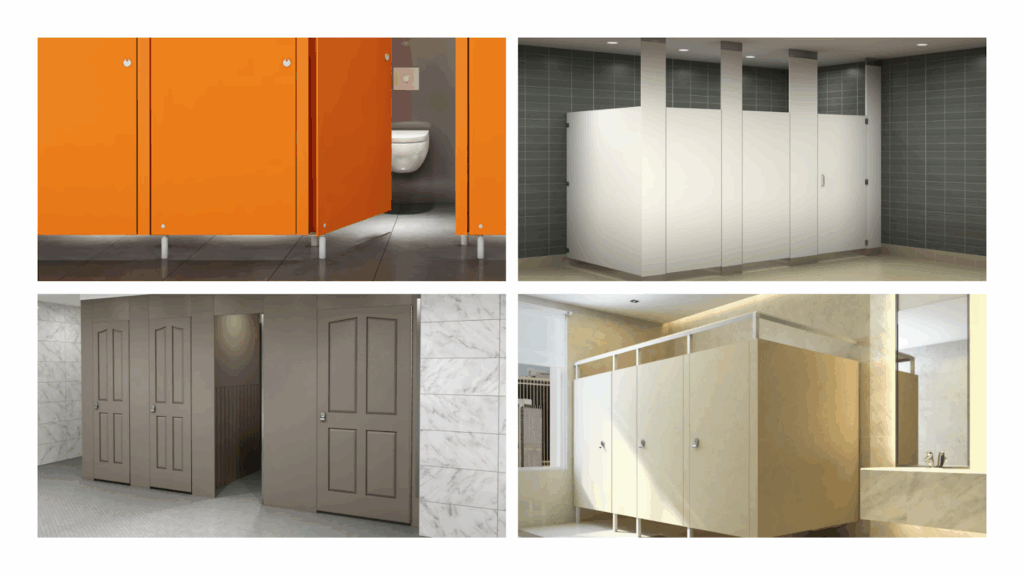Modern commercial restrooms have changed from functional necessities to experience zones where hygiene, efficiency, and perception intersect. Facility managers know that a well-planned restroom can reflect a company’s brand and support occupant satisfaction. Recent research projects the North American smart commercial restroom products market will grow to approximately US $1.07 billion by 2030, driven by hygiene demands and touchless technology.
Smart fixtures, from sensor-enabled faucets and flush valves to integrated sinks and connected occupancy systems, help improve the user experience. With the right blend of smart fixtures and purpose-built materials, restrooms in commercial buildings become safer, smarter, and more aligned with user expectations.
In this blog, we will explore what makes a restroom “smart,” examine major fixture categories, and show how GS Parcel can integrate high-tech and high-quality specialty products to deliver a superior facility experience.
What Makes a Restroom Experience “Smart”?
A “smart” restroom is planned around three principles: automation, efficiency, and data-driven management. Instead of relying on manual fixtures or reactive maintenance, smart restrooms integrate connected devices that anticipate user needs, streamline operations, and promote hygiene at every touchpoint.
At its core, a smart restroom uses sensor-based technology and IoT connectivity to transform routine interactions into seamless, contactless experiences. These fixtures reduce germ transmission and help facility teams monitor usage trends and maintenance requirements in real time.
Common features that define a smart restroom include:
- Touchless Functionality: Automatic faucets, flush valves, and soap dispensers minimize physical contact, reducing contamination and improving accessibility for all users.
- Smart Water Management: Built-in sensors track water flow and detect leaks, helping facilities cut consumption and utility costs without sacrificing performance.
- Occupancy and Maintenance Monitoring: IoT-enabled sensors can track foot traffic, notify staff when supplies run low, or flag malfunctioning fixtures before users notice.
- Energy Efficiency: Smart lighting and ventilation systems operate only when needed, lowering energy use while maintaining comfort.
- User Comfort and Aesthetics: Streamlined fixtures, ergonomic layouts, and well-coordinated finishes make restrooms feel modern and well-maintained, enhancing the overall building experience.
These innovations represent a shift toward predictive maintenance and long-term asset optimization, helping commercial spaces stay cleaner, safer, and more cost-efficient.
Core Smart Fixture Categories in Commercial Restrooms

Smart restrooms seamlessly integrate technology and thoughtful design to enhance hygiene, minimize maintenance, and improve the overall user experience. The following fixture categories represent the foundation of a modern, connected restroom system:
Touchless Faucets, Soap Dispensers, & Flush Valves
Hands-free operation has become important in commercial environments. Sensor-activated faucets, dispensers, and flush valves ensure that every interaction is contactless, promoting sanitation and water conservation. These systems also minimize wear and tear, extending fixture lifespan while reducing the need for frequent cleaning.
Sensor-Enabled Hand Dryers & Smart Sinks with Accessories
Modern hand dryers use infrared sensors and adaptive airflow to optimize energy efficiency and reduce drying time. When paired with integrated sinks and accessories, they create a seamless handwashing experience that’s both hygienic and visually cohesive, ideal for high-traffic restrooms.
IoT & Connected Monitoring Systems
Connected restroom systems give facility managers real-time visibility into how restrooms are used. Sensors can track occupancy, monitor water flow, and alert staff when supplies run low or maintenance is required. The result is a proactive, data-driven approach to restroom management that improves efficiency and user satisfaction.
Eco-Friendly & Efficiency-Focused Fixtures
Sustainability plays a major role in smart restroom design. Low-flow toilets, aerated faucets, and recirculating water systems help conserve resources without compromising comfort or cleanliness. These eco-friendly fixtures align with green building goals while lowering utility costs over time.
Each of these fixture categories contributes to a smarter, cleaner, and more efficient restroom, one that supports modern expectations for both hygiene and sustainability.
Integrating Smart Fixtures with GS Parcel’s Specialty Products
Smart fixtures perform at their best when paired with durable, thoughtfully created architectural components, the kind GS Parcel provides through its commercial specialty product offerings. High-quality toilet partitions and urinal screens strengthen this performance by delivering the privacy, stability, and visual consistency needed in modern restrooms.
Here are some of the options that we provide:

- Floor-Mounted Partitions
Floor-mounted partitions offer dependable stability and long-term strength, making them a practical choice for high-traffic commercial restrooms. Their straightforward installation and wide range of materials allow designers to match smart fixtures with durable, attractive finishes that hold up to heavy daily use.
Options & Advantages:
- Anchored directly to the finished floor for strong structural support
- Works well in restrooms with frequent traffic and routine cleaning
- Available in stainless steel, powder-coated steel, HDPE, and phenolic
- Flexible visual options to pair with smart faucets, flush valves, and dispensers
- Floor-to-Ceiling Partitions
Floor-to-ceiling partitions offer enhanced rigidity and elevated privacy, creating a premium restroom environment that complements modern smart fixture systems naturally. With anchoring points at both the floor and ceiling, they deliver increased structural integrity suitable for facilities aiming for long-lasting performance.
Options & Advantages:
- Full-height mounting improves stability and vandal-resistance
- Strong privacy solution for offices, hospitality, and public venues
- Compatible with multiple material and finish options
- Complements high-end smart fixtures and touchless technology
- Ceiling-Hung Partitions
Ceiling-hung partitions create a sleek, modern look with uninterrupted floor space for easy cleaning and maintenance. Their elevated design supports an organized, high-tech restroom layout, especially where smart fixtures rely on consistent hygiene and efficient servicing.
Options & Advantages:
- No floor contact points for improved sanitation
- Ideal for restrooms prioritizing easy daily cleaning
- Offers a minimal, streamlined aesthetic
- Works well in contemporary spaces with smart automation and sensors
- Full-Privacy (No-Gap) Partitions
Full-privacy systems eliminate sight lines and gaps to create a more enclosed, comfortable user experience. These partitions elevate restroom quality while aligning with environments where smart fixtures, sensors, and touchless features emphasize comfort, safety, and premium design.
Options & Advantages:
- Floor-to-ceiling panels with complete visual privacy
- Premium look that matches high-end restroom specifications
- Durable construction for demanding commercial environments
- Supports a more comfortable, spa-like restroom experience
- Overhead-Braced Partitions
Overhead-braced partitions balance durability, cost-efficiency, and quick installation, making them a popular choice for busy commercial facilities. Their reinforced headrail provides strong anti-sway support, creating a reliable structure that integrates well with smart fixture layouts.
Options & Advantages:
- Aluminum headrail increases stability under heavy use
- Cost-effective solution for high-traffic restrooms
- Suitable for a wide variety of materials and finishes
- Strong support for smart-fixture consistency and alignment
Benefits of Smart Restroom Systems for Commercial Facilities
Smart restroom systems redefine how commercial spaces approach cleanliness, comfort, and operational efficiency. Beyond the sleek appearance and modern convenience, they offer advantages that improve both the user experience and facility management.
- Enhanced Hygiene and Safety: Touchless fixtures and automated cleaning alerts help reduce cross-contamination, creating a healthier environment for employees, tenants, and visitors. Consistent sanitation standards also strengthen public confidence in shared facilities, a growing priority in workplaces, hospitality, and healthcare settings.
- Operational Efficiency and Cost Savings: Real-time monitoring systems provide actionable data on usage patterns, maintenance needs, and water or energy consumption. This allows facility teams to schedule cleaning only when necessary, reduce waste, and prevent downtime caused by malfunctioning fixtures, all translating into measurable cost savings.
- Improved Sustainability: Smart fixtures help buildings meet sustainability targets through controlled water flow, low-energy sensors, and optimized lighting. Over time, these efficiencies contribute to reduced utility bills and support certifications such as LEED or WELL Building Standards.
- Better User Experience: A clean, well-lit, and touch-free restroom enhances comfort and satisfaction for occupants. Smart restrooms also ensure a consistent experience across visits, giving employees and guests a sense of reliability and care that reflects positively on the brand.
- Data-Driven Maintenance: Connected systems take the guesswork out of restroom management. Sensors that track supply levels or fixture performance enable proactive maintenance, preventing issues before they disrupt service. Facility managers gain insights that help refine budgets, staff allocation, and long-term planning.
Design & Implementation Considerations

Smart restroom design should be a cohesive, reliable, and future-ready environment that serves every user efficiently. Each facility has its own priorities, and planning for smart fixtures means understanding how usage patterns, infrastructure, and design elements come together for long-term success.
Usage Profile & Environment
Smart restroom planning starts with understanding where and how the space will be used. High-traffic areas like airports, schools, and retail centers benefit from durable, quick-response fixtures that handle constant use with minimal maintenance.
Office floors and hospitality settings, on the other hand, often focus on comfort, aesthetics, and quiet operation. Matching fixture type to environment ensures the right balance between performance, hygiene, and user experience.
Infrastructure Readiness
Before implementation, facilities must evaluate their plumbing, electrical, and data infrastructure. Smart fixtures depend on reliable power and connectivity to enable sensors, real-time monitoring, and data collection.
In some cases, upgrades to water lines or network access points are necessary to support automated systems and ensure consistent performance.
Integration with GS Parcel’s Specialty Elements
Smart fixtures perform best when integrated with well-designed restroom components. GS Parcel’s partitions, wall protection, restroom accessories, and ADA-compliant signage help complete the system.
Together, they create environments that are intelligent, functional, private, and easy to maintain, providing the durability and visual harmony that commercial restrooms require.
Maintenance & Support Plan
Technology-driven fixtures require a proactive maintenance approach. Facilities should plan for sensor calibration, periodic data checks, and staff training to handle smart systems effectively. Many modern fixtures also provide diagnostic data, allowing facility managers to schedule service before issues arise, minimizing downtime and repair costs.
Budget & Lifecycle View
Smart restrooms may involve a higher upfront investment due to sensors, connectivity, and data systems. However, over time, lower water and energy consumption, reduced maintenance labor, and fewer service interruptions lead to measurable savings. A lifecycle view helps facility managers justify the initial cost with long-term value.
Accessibility, Privacy, & Durability
A truly modern restroom balances technology with human-centered design. Touchless operation enhances accessibility for all users, while partitions and wall protection preserve privacy and withstand daily wear. When combined, these elements deliver a complete, future-proof restroom experience that stands up to both time and traffic.
Upgrade Your Facility with Intelligent Restroom Solutions From GS Parcel

Modern restrooms reflect the quality, safety, and innovation behind every commercial space. GS Parcel helps facilities elevate these environments with intelligently integrated solutions, from smart fixtures and wall protection to restroom partitions, signage, and accessories that work together seamlessly.
Our team partners with architects, contractors, and facility managers to deliver complete restroom systems that balance technology, accessibility, and long-term durability. Whether upgrading an office, school, hospital, or retail property, every GS Parcel solution is created for performance, precision, and visual consistency. Enhance comfort, efficiency, and user satisfaction in your facility’s restrooms. Connect with GS Parcel today to explore smarter, future-ready restroom design solutions tailored to your building’s needs.
